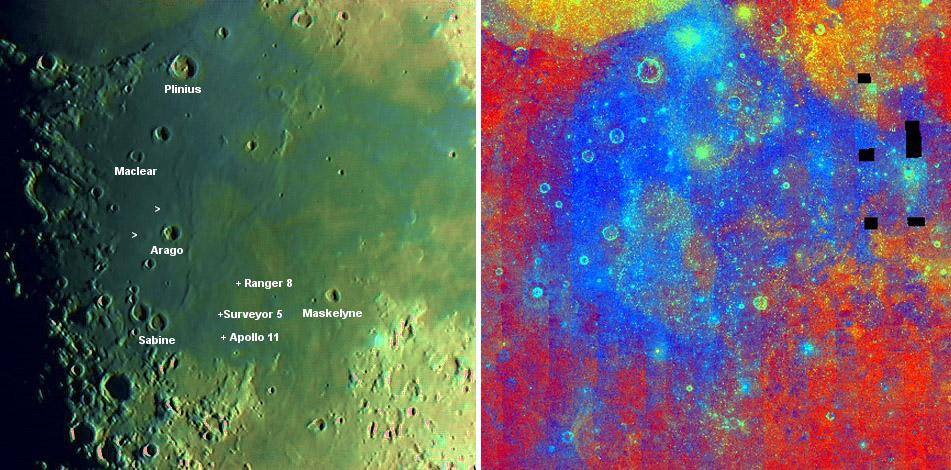
Left image by John C McConnell and right one from Clementine via Map-A-Planet
The Moon shows almost no color to the observer on Earth nor to the astronauts lucky to be on its surface. But there are subtle color differences relating to the chemical compositions of the soils, most especially the abundance (mare) or lack (highlands) of iron and titanium. This difference is visible to the naked eye - maria are dark and highlands are bright - but it takes multi-filter imaging (right) to bring out the subtle differences. Or, if you lack a hundred million dollar spacecraft, you can get a feeling for the color differences on the cheap. John used a small telescope and color webcam for the image on the right. This image appears in shades of gray normally, but by stretching the color balance, John made an image where yellows mark the highlands and a greenish-blue colors the maria. The hues are somewhat consistent with the Clementine image. The slightly ruddy color east of Vitruvius (top right in left image) is different from the pale yellow of the highland patch at the bottom right, and the Clementine image also shows a difference in color for these two areas. Also the ghostly patches of yellowish-green in the maria (left image) are areas of slightly different color and compositions in the Clementine view. The real differece between most amateur color images and Clementine ones is that the latter are usually calibrated so that there is confidence that a given color represents the same composition anywhere on the Moon. But images like those on the left are a delight for the photographer and a pleasure for the rest of us - who cares about calibration!
Technical Details:
4 Apr. 2006. Meade ETX90 f/13.8 at prime focus + Philips TouCam Pro 2; ~300 frames aligned and stacked in Registax. CAW note: I believe this is the first picture ever on LPOD taken with an ETX90.
Related Links:
Rükl plates 35 & 36
East Antrim Astronomical Society website
Yesterday's LPOD: A Line of Domes
Tomorrow's LPOD: Mystery Photo
COMMENTS?
Register, Log in, and join in the comments.



